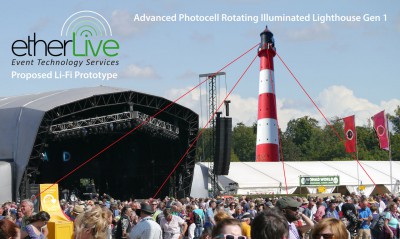 Sorry to disappoint, but yes our blog last week on Li-Fi at festivals was an April Fool’s joke. The response to it though highlights just how much importance people put on remaining connected whilst at events.
Sorry to disappoint, but yes our blog last week on Li-Fi at festivals was an April Fool’s joke. The response to it though highlights just how much importance people put on remaining connected whilst at events.
Li-Fi is a real technology and does hold promise but it is practically much more suited to indoor environments and certainly not outdoor lighthouses! As with many technologies theoretical speeds are indeed very fast in the lab but real-world use is some way off, in the meantime Wi-Fi and 3G/4G remain the primary options for keeping connected.
All is not lost though as these technologies continue to develop, and more and more events are deploying infrastructure to improve attendee experience. Wi-Fi has moved a long way from the days of 11Mbps 802.11b, one of the first standards. Modern 802.11ac wireless access points support far more users, offer much higher speeds and contain a raft of technology to create the best user experience. A well designed high-density Wi-Fi deployment using 802.11ac and directional antennas can support thousands of simultaneous users and still provide good speeds.
The rapid deployment of 4G infrastructure by mobile carriers has improved connectivity at smaller events but events attracting more than a few thousand quickly overload cell towers which are limited by spectrum availability and coverage size.
Testing is underway with new technologies which may help – the first is LTE-U (Long Term Evolution Unlicensed) which more simply put is using unlicensed spectrum such as 5 GHz to deliver additional 4G capacity. The challenge is that this technology introduces yet another connectivity method into what is becoming very congested spectrum. It is in effect robbing Peter to pay Paul and therefore the approach has split the industry due to concerns over the impact it may have on Wi-Fi installations.
Another approach in testing, supported by Ruckus and Qualcomm amongst others, is OpenG using shared spectrum at 3.5 GHz in the US. It is not dissimilar to LTE-U but because it uses different shared spectrum does not clash with existing Wi-Fi. With the Ruckus solution the 3.5GHz radio is being integrated into existing dual-band Wi-Fi access points providing a triple radio solution in one unit which can be deployed easily.
Wi-Fi also continues to evolve with 802.11ac now at ‘wave 2’, a fuller implementation of the standard featuring ‘Multi-User MIMO’, a way of better utilising spatial channels across devices giving increased capacity. Then there is 802.11ax, touting speeds of 10 Gbps but we won’t see that any time soon as the standard is unlikely to be ratified until at least 2019 by which time Li-Fi may also be a reality!
Unfortunately, as is typical with these mobile technology evolutions, once testing and approval is complete there is a lag whilst the mobile handset manufacturers catch up with integrating the technology and penetrating the market which can add several years before mass market adoption is reached.
In the meantime, well implemented 802.11ac Wi-Fi remains the best approach for high density connectivity, and that’s certainly what we will be using this summer.





 Since our move to Royal Wootton Bassett in 2015 we thought we should look for some ways to help the local community. Etherlive has always had an active community programme and much of this has been in education including working with organisations such as Young Enterprise, Bath University, Bristol University, Bucks New University and several Wiltshire schools & colleges.
Since our move to Royal Wootton Bassett in 2015 we thought we should look for some ways to help the local community. Etherlive has always had an active community programme and much of this has been in education including working with organisations such as Young Enterprise, Bath University, Bristol University, Bucks New University and several Wiltshire schools & colleges. For event organisers life on the road, in and out of venues, holed up in damp cabins and questionable hotels means the technology they carry and the software tools they use are critical to their day to day job. It’s an ever changing landscape and, to some degree, a personal preference but there are a few key items to think about to ensure the teams stay productive at a sensible cost.
For event organisers life on the road, in and out of venues, holed up in damp cabins and questionable hotels means the technology they carry and the software tools they use are critical to their day to day job. It’s an ever changing landscape and, to some degree, a personal preference but there are a few key items to think about to ensure the teams stay productive at a sensible cost.